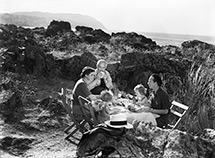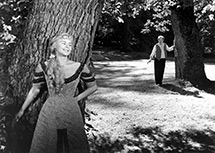With more than 143,000 inhabitants, the city of Helsingborg is Sweden’s eighth largest municipality.
The city was mentioned in a deed of gift sent by the Danish king Canute the Holy to Lund Cathedral on 21 May, 1085, a date that has become the city’s ‘birthday’. The Helsingborg referred to back then was located up on the plateau known as Landborgen.
Kärnan
Today only Kärnan remains of the medieval town that once existed here. This is the 34-metre high keep of Helsingborg Castle, a fortification built in the 12th century which featured a surrounding ring-wall and a square brick tower dating from the 14th century. The city of Helsingborg later expanded on the narrow strip of beach below the Landborg plateau.
Over the centuries, Helsingborg has been the site of several battles and political conflicts. Although the numerous wars between Sweden and Denmark took their toll on the city and its settlements, it has lived in peace since the 18th century. Its urban planning is today characterised by the architectural styles of the late 19th and early 20th centuries, when Helsingborg developed into a thriving commercial, industrial and maritime city. A steamship connection between the city and Helsingör (or Elsinore) on the Danish side was opened in 1892, and its wooden ferry station was built in 1899. The city hall on the north side of Stortorget was completed in 1897 and the terraced flights of steps behind the square added in 1903 to connect the upper and lower parts of the city.
Helsingborg City Theatre
The City Theatre was founded in 1921 and became the country’s first permanent ensemble theatre based in a city. As far back as 1813, a theatre was established here for travelling theatrical groups – this built by Achates von Platen, who at the time owned the Ramlösa Brunn spa. In 1944, at the age of only 26, Ingmar Bergman became the director of the theatre. He remained there until 1946 and, for much of that time, lived on Norra Storgatan 14, the building which today houses the Telegrafen pub.
Since the theatre had not originally been built with a permanent ensemble in mind, the premises gradually became less functional. In 1976, the new City Theatre opened next to the Concert Hall on Henry Dunkers Plats. The old theatre was demolished in the same year and, in 2008, the site on Bruksgatan was christened Ingmar Bergmans Plats.
The Concert Hall
The Concert Hall, designed by Sven Markelius, opened on 12 November, 1932 and was one of the first functionalist buildings constructed in Sweden. The building is still much admired today for its beautiful lines, harmonious colour scheme, mahogany and ebony walls and perfect acoustics. In 1997, the Concert Hall was listed as a historic building.
During his time in Helsingborg, Bergman often visited the Concert Hall, and it was here that he found inspiration for To Joy, which he filmed a few years after leaving the city. (Learn more about these scenes here.)
Beaches and coastal walks
Helsingborg is known for its many beaches – Tropical Beach, Fria Bad, Gröningen, Vikingstrand and Rydebäck – and beach bars, as well as its long coastal paths, which start at the bottom of Tinkarpsbacken in the north and continue almost three kilometres south to the end of Gröningen and the entrance to the North Harbour. Bergman would most likely have taken a walk or two here during his time in Helsingborg. Beaches and the sea appear in some of the scenes from his comedy A Lesson in Love, which was released eight years after he left Helsingborg. (Learn more about these scenes here.)
Shot in Helsingborg:

Shot in the summer of 1949, To Joy is about a mediocre violinist in a symphony orchestra who dreams of a successful solo career while having to deal with rumblings of disquiet in his marriage. Classical music is central to the film, which features long scenes from rehearsals and concerts. In the words of the conductor (Victor Sjöström), it is ‘a joy so great, so particular, that it lies beyond pain and boundless despair … a joy beyond all understanding’.

This elegant marital comedy, in which gynaecologist David Erneman (Gunnar Björnstrand) follows his wife Marianne (Eva Dahlbeck) to Copenhagen en route to meet her lover, was shot in several locations throughout Skåne, including Ramlösa, Pålsjö Forest and Arilds Nabb. The action alternates between the present and the past.
Points of interest:
Nils Poppe, the comedian who ran the Fredriksdal Theatre from 1966 to 1994, appeared rather unexpectedly as an actor in Bergman’s Seventh Seal and The Devil’s Eye.
The popular Fredriksdal Theatre was founded in 1927 and held its first performance on 27 July, 1932. It is located in Fredriksdal’s Open-Air Museum, which was, in 1918, donated to the city of Helsingborg by Consul Trapp’s widow, Gisela Trapp. Now run by Eva Rydberg, famous Swedish actress and theatre director, the theatre performs to capacity audiences every summer.


